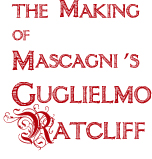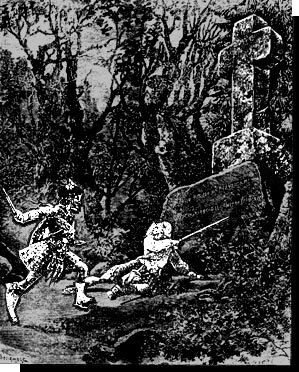 |
<< Previous

Ratcliff's bad day at Black Rock
There are two other "subsidiary" melodies: the "Black Rock" motive and the melody of the "Mirror". (It should be understood that these titles are used only for the sake of convenience; they were never so labeled by the composer.) The "Black Rock" motive occurs only in the first act, though because of its chromatic nature hints of it seem to reappear throughout the opera. It is first presented as an inner voice in the orchestra after MacGregor's words, "Ogni indagine nostra nadò delusa!" and then in its full guise when MacGregor tells Douglas how Duncan's body was found at the Black Rock. The inner voice treatment returns a second time when MacGregor says they could find no trace of Ratcliff after the murder ("orma dell'assassino in nessun loco"): it would seem that Mascagni felt Ratcliff could still be found at the Black Rock! The final appearance of its full treatment is at the close of act one, as Douglas foes off to the duel with Ratcliff. It is here played a half tone higher than the preceding time: an ingenious idea of Mascagni's to use it at this point rather than during MacGregor's solo. It is no longer narrative but action.
The so-called "Mirror" theme is heard only in the fourth act: when Ratcliff tells Maria how they both resemble the two spectres and shows her the proof in a mirror; and at the final curtain, after Margherita shows the bodies of Maria and Ratcliff to the guests: "Hanno sembianza, quasi, d'Edvardo e della Bella-Elisa." Recalling this theme was a masterstroke on Mascagni's part and shows how aware he was of the necessity for total truth in every aspect of composition. It was a credo that he was to follow during his entire career.
The repetition of MacGregor's Act One (opening) benediction music at the beginning of Act Four serves more to remind the audience where the action is rather than for any psychological reason. It was also necessary to recall it from a different point of view, that of the overall form, which can now be considered in some detail.
It is also worthwhile to note that the "Black Rock" theme is nothing more than a motto, but one played fortissimo, with the addition of a cymbal punctuating it. It is a very typical Italianate gesture, also one that can send shivers up the audience's spinal column in its force. (The last two measures repeat, and resolve in different ways when presented.)

In addition, the "wedding" motif mentioned as repeated from Act One to Act Four is most unusual in that it is written in a 5/4 signature (which can be divided either as 3+2 or 2+3), a sure sign of Mascagni's wish to be "modern" in evey sense of the word. While he has several such measures in I Rantzau, in places Ratcliff is a veritable rat's nest of changing meters which we really don't see again in his work until the splurge of dramatic tensions in Isabeau (and where one of the main themes is in a very sure 5/4 meter). It is a technique no one has really addressed well with regard to Mascagni's work. His experiments in changing meters is evident in Cavalleria, with the choral contrasts, as mentioned above (and not much else in that opera); I Rantzau has its more fragmented moments (where at times the meter is interrupted in mid-measure by a new meter, and in the score that interruption is expressed by being in parentheses!—I don't believe that's done anywhere else except perhaps in works by Cage or Crumb).
So far as Ratcliff goes, perhaps no other Mascagni opera plays with meter quite so much, even down to writing out one measure in 5/4 followed by a measure in 4/2 (instead of indicating a ritandando in the Prelude), or appending one measure of 1/4, instead of lengthening the previous measure by one beat, or using a fermata. (Puccini happens to use this technique in Butterfly too, and it is only in Alban Berg's Lulu that we see a whole scene written in the odd signature of 1/4. The comparison with Berg may seem to be an off-the-charts bi-polar one in Mascagni's case, but actually the two composers had similar ideas about how operas are constructed and how performers should interpret a score. See the table on the next page, and notice that it isn't too far off from the similar table Berg devised for Wozzeck or Lulu.)
Even more curiously, in Mascagni's operas in which one might expect shifting meters for the sake of the exotic subject matter, such as Iris, we find the music surprisingly straightforward, written almost entirely in 2/4, 3/4 and 4/4, and in long stretches of each.
|